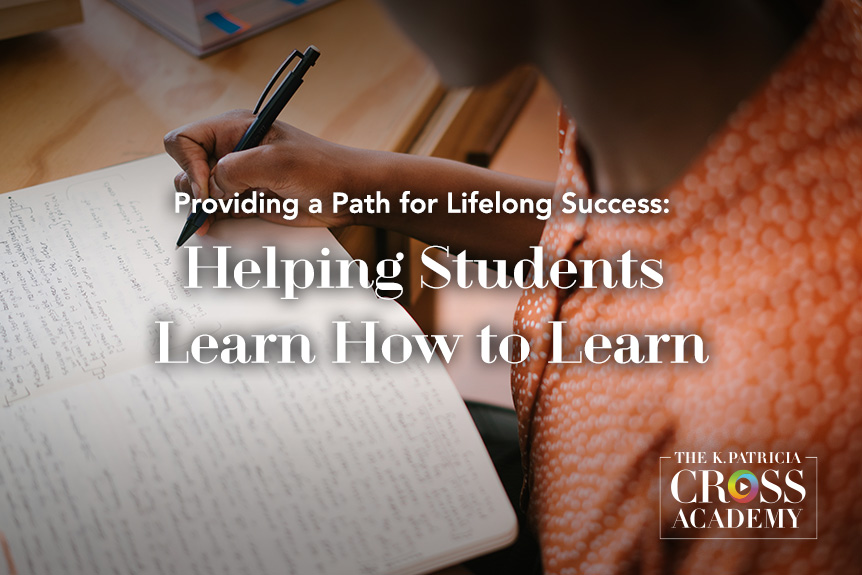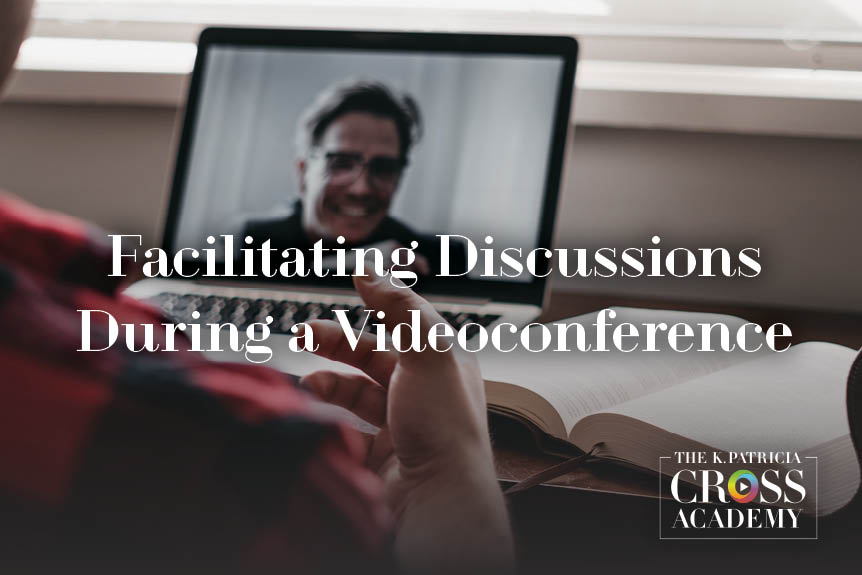
With many of us now teaching remotely, we are finding ways to retain strategies that worked well when teaching onsite. Discussion is one of the strategies that we regularly draw upon when teaching on campus. Thus, instructors who are using videoconferencing to facilitate our class sessions are trying to determine how to make synchronous class discussions work in this new environment.
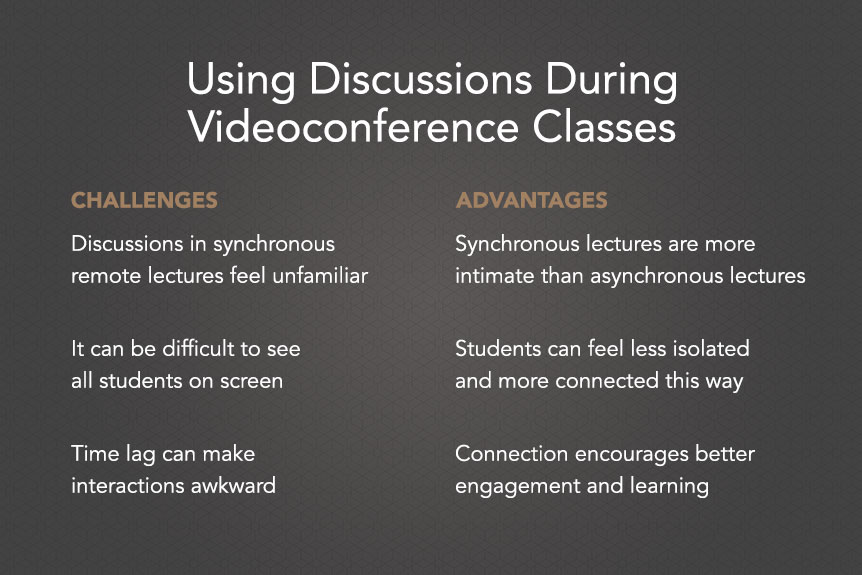
Challenges and Advantages of Using Synchronous Discussions During Videoconference Classes
Using discussion during synchronous videoconferenced class sessions is neither familiar nor easy to most of us. Students appear on the screen in windows the size of postage stamps, and at times, not everyone is even visible. There is also typically a lag between the time a person begins talking and then assumes “center stage” on the screen. It can feel forced and awkward to try to engage in class discussions under these conditions.
Despite these challenges, videoconference discussions also offer some significant benefits to those of us teaching remotely. For example, they occur synchronously. Thus the “transactional distance” (the psychological and communicative space between the instructor and learner) is lower than when using asynchronous discussion. In videoconference supported discussions, students are “in the moment” with other students and the teacher. This approach in turn can help students feel less isolated and more connected. This sense of connection encourages engagement and can promote deeper learning. Therefore, while it can be challenging to use discussion effectively during videoconference class sessions, doing so can reap significant benefits and is typically worth the effort. The trick is to find good ways to overcome the challenges and maximize the benefits.
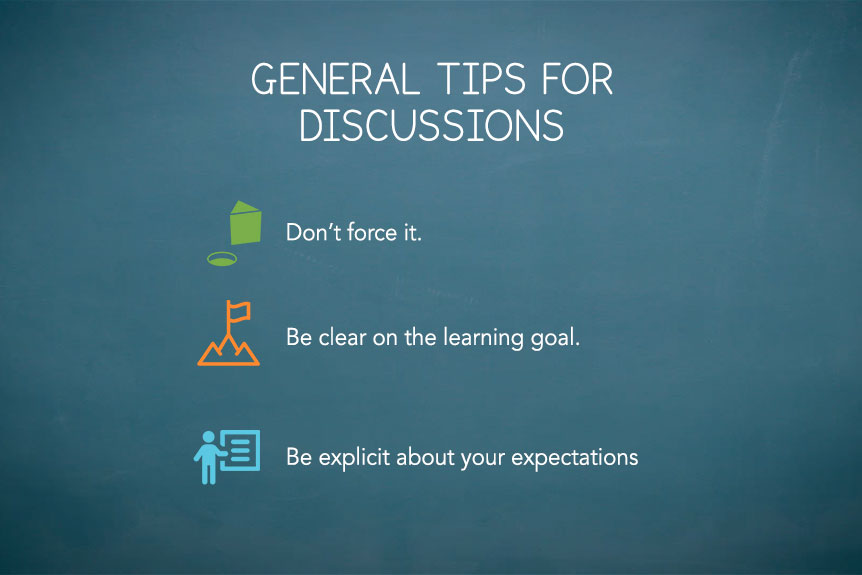 General Tips for Discussion via Videoconference
General Tips for Discussion via Videoconference
Don’t force it.
Acknowledge that in a videoconference call, particularly in a relatively large class, discussion will be different. The discussion won’t likely proceed as naturally as it does in a face-to-face conversation, and the pacing will not be as quick. You don’t have to replicate an onsite discussion; indeed, it is best to think of it as a new way of communicating.
Be clear on the learning goal for the discussion.
Having a clear learning goal is essential. If you don’t have a good reason for using discussion, then don’t do it. If it will help students apply information and make connections between ideas, and with other students and with you, then do it. But keep your learning goal central. Doing so will allow you to craft an engaging, focused prompt. It will also help you to redirect the discussion if it goes off track.
Be explicit about your expectations.
It is important to let students know the length, quantity, and quality of contributions you hope they will provide. While you want to encourage spontaneity and originality, they should have a sense of what constitutes an effective synchronous online discussion. As like us, few students have participated in this particular type of discussion before. Providing them with some ground rules and some ideas about what a good discussion can look like will go a long way in helping the discussion be a successful one.
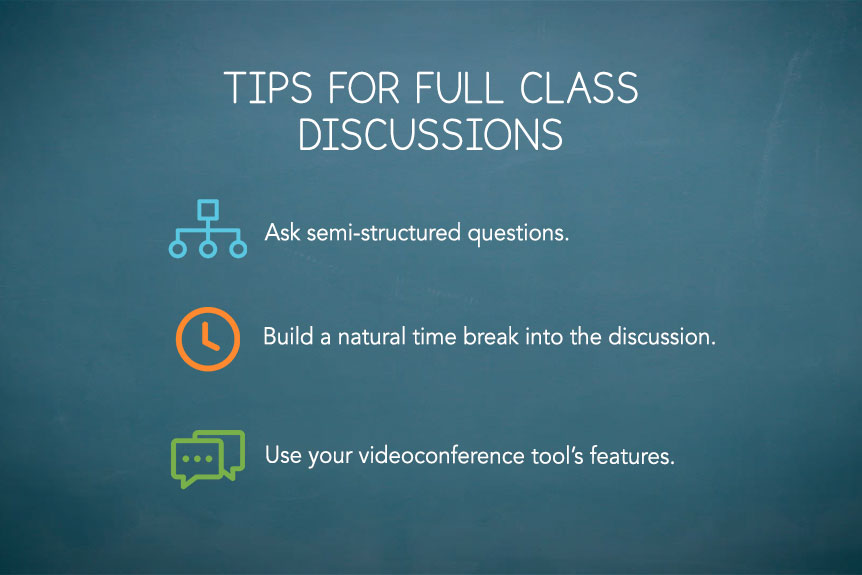 Tips for Full Class Discussions During a Videoconference
Tips for Full Class Discussions During a Videoconference
Prepare a variety of questions.
Crafting a set of questions ahead of time can help you facilitate it in real-time. The questions can be open-ended, for example starting with terms like “how did” or “why,” but they may also include close-ended questions. This approach helps keep the discussion on track and provides you with feedback to ensure that students are meeting the learning goals.
Build in a natural time break into the discussion.
Lean into the technology-induced time lag rather than trying to avoid or minimize it. For example, you can offer the prompt, build in a break that gives students some time to think or write, and then ask for verbal responses. The break gives students something meaningful to do during the delay, and it can also help to decrease self-consciousness.
Use the tool’s features.
Most videoconferencing programs have many useful tools you can use. For example, because you likely won’t be able to fully see students and may miss a physical raised hand, you can ask students to virtually raise a hand or to record their questions or answers in the chat pane. Moreover, many programs allow students to record a response, such as clapping or a thumbs up simply by clicking an icon. They often have white boards and allow for screen sharing. Using the tools adds variety and can help facilitate the discussion by allowing students to participate in non-verbal ways.
Tips for Smaller Group Discussions during a Videoconference
Use your tool’s breakout room feature.
This feature allows you to put students into smaller groups. You can randomly assign students to breakout rooms or choose how to form the groups. You then can circulate among the breakout rooms to check-in with students, and students are also able to “request help” as needed.
Make sure you provide students with a specific task or ask them for a deliverable.
In online synchronous discussions, students need to know what to do, how long they have to do it, and how they should record their work. For example, you can ask students to use the whiteboard feature to record their ideas. In addition, you can push a message to all breakout rooms at the same time, for example, “you have 5 minutes left before you will report out to the full group.” For specific discussion techniques that can work well during a small group breakout during a videoconference, consider the following options:
Fishbowl
In Fishbowl, students form concentric circles with a small group inside and a larger group outside. Students in the inner circle engage in an in-depth discussion, while students in the outer circle listen and critique content, logic, and group interaction. To use a Fishbowl technique during a videoconference, ask a prompt and then select 3-4 students to respond while the others listen.
View main video here: View Technique →
View online adaptation here:
Jigsaw
In a Jigsaw, students work in small groups to develop knowledge about a given topic before teaching what they have learned to another group. To use Jigsaw during a videoconference session, assign base groups, then take one member from each base group to form jigsaw groups to work in breakout rooms. You can then return students to their original jigsaw groups in new breakout rooms.
View main video here: View Technique →
View online adaptation here:
During this pandemic, students are often isolated and sincerely appreciate the opportunity for human connections. Making those connections over academic content is one of the key ways to encourage them to continue on in their studies and to deepen their learning as they do so. This real-time learning approach also provides students with the opportunity to share concerns and to ask questions that they might not choose to do if not in the moment. You are also able to respond in the moment and to provide students with immediate feedback, which is an important practice for ensuring students are learning. While using discussion as a way of teaching during videoconferences can be a challenge, if you have a clear goal and a good plan, you will likely find the activity is well worth it for the benefits it provides.
Sign Up for Our Newsletter
Enter your email below to receive information about new blog posts.
Suggested Citation
Barkley, E. F., & Major, C. H. (n.d.). Facilitating discussions during a class videoconference. CrossCurrents. https://kpcrossacademy.org/facilitating-discussions-during-a-class-videoconference/

Engaged Teaching
A Handbook for College Faculty
Available now, Engaged Teaching: A Handbook for College Faculty provides college faculty with a dynamic model of what it means to be an engaged teacher and offers practical strategies and techniques for putting the model into practice.





